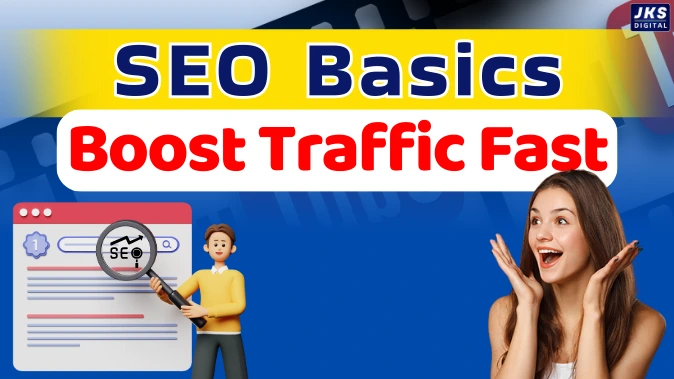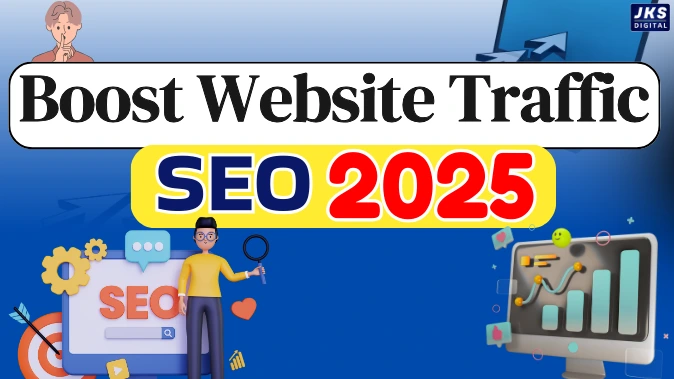SEO for Beginner:- SEO Basics: If you’re just starting out with SEO (Search Engine Optimization), it can feel overwhelming. But don’t worry—this guide is here to help you understand the basics and give you some actionable steps to start improving your website’s visibility. SEO is one of the best ways to drive free, organic traffic to your site. Let’s break it down!

1. What Exactly is SEO?
SEO stands for Search Engine Optimization, and it’s all about making your website more visible on search engines like Google. When someone searches for a term that’s relevant to your business, SEO helps your site appear higher in the search results, bringing more visitors your way.
2. Why SEO Matters for Your Website
SEO is crucial because it helps people find you. Instead of paying for ads, SEO allows you to naturally appear in search results when someone is looking for something you offer. The more optimized your website, the higher it ranks, meaning more eyes on your content, services, or products.
3. Start with Keywords
Keywords are at the heart of SEO. These are the words or phrases people type into search engines. For example, if you run a bakery, keywords like “best cupcakes near me” or “gluten-free cake recipes” might be what your audience is searching for.
To start, do some basic keyword research using free tools like Google Keyword Planner or Ubersuggest. This will help you find out what terms people are using to find businesses like yours. Once you know your keywords, use them naturally in your content, titles, and meta descriptions.

4. On-Page SEO: Get Your Website in Shape
On-page SEO focuses on the elements you can control on your own website. Here are a few things to focus on:
Read Also – Step-by-Step Guide to Adding Custom Fonts in WordPress
- Title Tags: These are the clickable titles that show up in search results. Make sure they’re clear, relevant, and include your target keyword.
- Meta Descriptions: These are the short descriptions under the title in search results. Write a compelling summary that encourages people to click.
- Headers (H1, H2, H3): Use headers to break up your content. Not only do they make your content easier to read, but they also help search engines understand the structure of your page.
- Image Alt Text: This describes your images to search engines. Adding descriptive alt text that includes keywords can give your SEO a boost.
- Internal Linking: Link to other pages on your site to help visitors navigate easily and improve your SEO ranking.
Read Also – Free Local Server for WordPress Website: A Complete Guide
5. Make Sure Your Site is Technically Sound
Technical SEO refers to the behind-the-scenes elements that help search engines crawl and index your website. If your site has technical issues, it can hurt your ranking. Here’s what you need to look at:
- Site Speed: If your site takes too long to load, visitors will leave, and search engines will notice. Use tools like Google’s PageSpeed Insights to check your speed.
- Mobile-Friendliness: Your site should work just as well on a phone as it does on a computer. A mobile-friendly site is a must for SEO.
- XML Sitemap: This file helps search engines understand your site’s structure, so make sure it’s up to date and submitted to search engines like Google.
6. Content is the Backbone of SEO
High-quality, relevant content is one of the best ways to boost your SEO. Write for your audience, not just for search engines. Your content should provide real value and answer the questions your visitors have. Whether it’s blog posts, product descriptions, or how-to guides, your content should be original, useful, and updated regularly.

7. Backlinks: Why They Matter
Backlinks are links from other websites to yours. Think of them as votes of confidence from other sites. The more high-quality backlinks you have, the more search engines trust your site, which can improve your rankings. Here are a few ways to build backlinks:
- Guest Blogging: Write articles for other websites and include a link back to your site.
- Shareable Content: Create valuable content like infographics, guides, or videos that others will want to share and link to.
- Outreach: Reach out to industry bloggers or influencers and ask if they’d be willing to link to your content.
8. Track Your Progress
SEO isn’t a one-and-done deal. It’s important to regularly check how your site is performing. Tools like Google Analytics and Google Search Console can help you monitor traffic, see which pages are doing well, and find areas for improvement.
- Check Your Traffic Sources: See where your visitors are coming from—organic search, social media, or direct traffic.
- Monitor Keyword Rankings: Track how well your pages are ranking for your target keywords.
- Bounce Rate: If people are leaving your site quickly, it might mean your content isn’t engaging enough, or your site needs improvements.
Read Also – Top 5 WordPress Contact Form Plugins to Boost User Interaction
9. Don’t Forget Local SEO
If you’re a local business, don’t forget about local SEO. This is about optimizing your site to attract people searching in your specific area. Claim your Google Business Profile, make sure your business name, address, and phone number are consistent across directories, and encourage happy customers to leave reviews.
Conclusion
SEO can be a game-changer for your website traffic, but it takes time and consistent effort. By understanding the basics—like keyword research, on-page optimization, technical fixes, and quality content—you’ll be well on your way to boosting your site’s visibility. Stick with it, track your results, and adjust as needed to keep improving.





